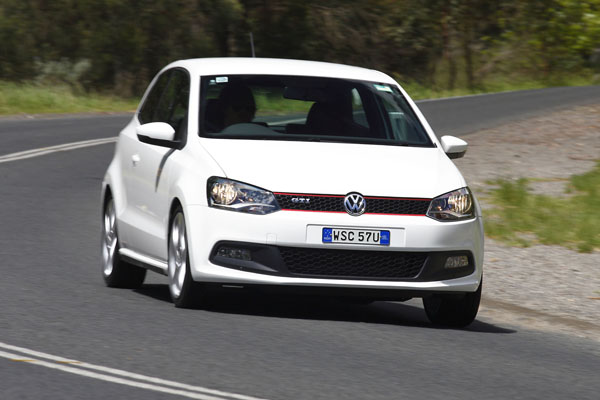Volkswagen Polo has the solid German feel that’s simply not felt in Asian competitors in this class. Owners we have spoken to like them for that, saying they feel safe and secure. Just as importantly they love the way they handle in a European manner.
Polo was a relatively slow seller in Australia prior to 2010 when a new model was introduced in April of that year. Older Polos had been on the bland side in appearance, the new one had a bit of oomph to its shape, and potential buyers liked that.
It was a little larger than previous models so can be used as a family car if the children are in their pre-teen years. The front seats support nicely without being overly aggressive. The seating position in front is quite high to provide for extra room behind them. Try before you buy, though.
The interior is very Volkswagen in that it’s functional and the driver has neat layout that’s easy to use and controls that fall easily to hand.
Though larger, the 2010 Polo was a little lighter thanks to the use of a combination of high strength materials. It has a five-star EuroNCAP rating.
A makeover in August 2014 saw the Polo’s shape revised front and rear, with slightly sharper lines. While it still doesn’t exactly jump out from the crowd style-wise it is likely to remain timeless, and many like it like that.
Infotainment was becoming a strong selling feature by this time and the 2014 Polo has a 5.0-inch touch screen. AM/FM radio, CD player, Aux socket, SD card slot and is compatible with MP3 and WMA music files.
Petrol engine capacities in the standard models are 1.2 and 1.4 litres. Performance from the smaller engine is better than you might expect due to the little VW’s relatively light weight. From the 2014 makeover the 1.4-litre was discontinued and the 1.2 was offered in two different states of tune depending on the model.
The 1.6-litre turbo-diesel from 2010 onwards is a much better unit than the old-style 1.9-litre in previous Polos so is well worth consideration. However, diesels in the small car class in Australia have never been popular and the oil burner was discontinued with the introduction of the 2014 facelift.
The sporty Polo GTi is worth looking at as it’s modestly priced for its type. The GTI launched in November 2010 had 132 kW from VW’s fascinating 1.4-litre TwinCharger (supercharged and turbocharged) engine was installed.
This engine was superseded by a conventional turbo unit producing up to 141 kW in 2016.
Firmer suspension and added precision through the steering means it provides driving enjoyment at a very modest price. On the styling front the GTi has the usual subtle red touches to the body and the not so subtle tartan seats.
Unlike previous GTi variants it was offered in five-door format. The three-door continued.
VW dealers still tend to congregate in major metro areas, but an increasing number are being set up in country cities and large towns in the bush.
Service and repairs are moderate in price, though they can be higher than for equivalent Asian sourced cars. We have heard of no real complaints about the cost or availability of spare parts.
A good amateur mechanic should be able to do a fair bit of their own work as the Polo has a simple mechanical layout. In a car of this size the underbonnet area is quite crowded. Have a repair manual at your side, and keep well clear of repairs that could affect the car’s safety.
Insurance costs are about average for a car in this European class, but you are likely to be charged extra to cover the Polo GTi, especially if you have a poor insurance history and / or are a younger driver.
A virtually all-new Polo was launched in March 2018, it’s significantly larger car. We won’t cover it in this feature.
WHAT TO LOOK FOR
Look for a full service record from a Volkswagen specialist.
There have been several major recalls and it’s vital they have been carried out. The ACCC site ate https://www.productsafety.gov.au/products/transport/cars/volkswagen for details.
Look over the body carefully for any dings or scratches because Polos are often used as city and near-city cars and can suffer lots of minor damage.
Examine the wheels for damage caused by kerbing. The front-left is often the first to suffer.
Ensure the engine starts quickly and idles reasonably smoothly immediately it fires up. Diesels will be slower to start than petrols.
Check the DSG automated manual gearbox works correctly at all times, particularly at very low speeds while parking.
Manual gearboxes should be light and easy with no crunching when you shift down quickly. The clutch should be smooth and predictable in its operation
Be sure that all electrical items work correctly, particularly the infotainment system. Using the owner’s manual is the best way to check you’ve tried it all.
HOW MUCH?
Expect to pay from $3000 to $5500 for a 2010 Volkswagen Polo Trendline; $6000 to $10,000 for a 2010 GTi or a 2012 Comfortline; $8000 to $12,000 for a 2013 Comfortline; $9000 to $14,000 for a 2016 Comfortline; $10,000 to $15,000 for a 2013 GTi; $11,000 to $17,000 for a 3027 Beats; $14,000 to $20,000 for a 2016 GTi; and $17,000 to $23,000 for a 2017 GTi;
CAR BUYING TIP
Always take a friend with you when checking cars, having them listen to the sales people lets you spend uninterrupted time on checking the car
RECALLS: To browse recalls on all vehicles go to the ACCC at: www.productsafety.gov.au/products/transport/cars/
